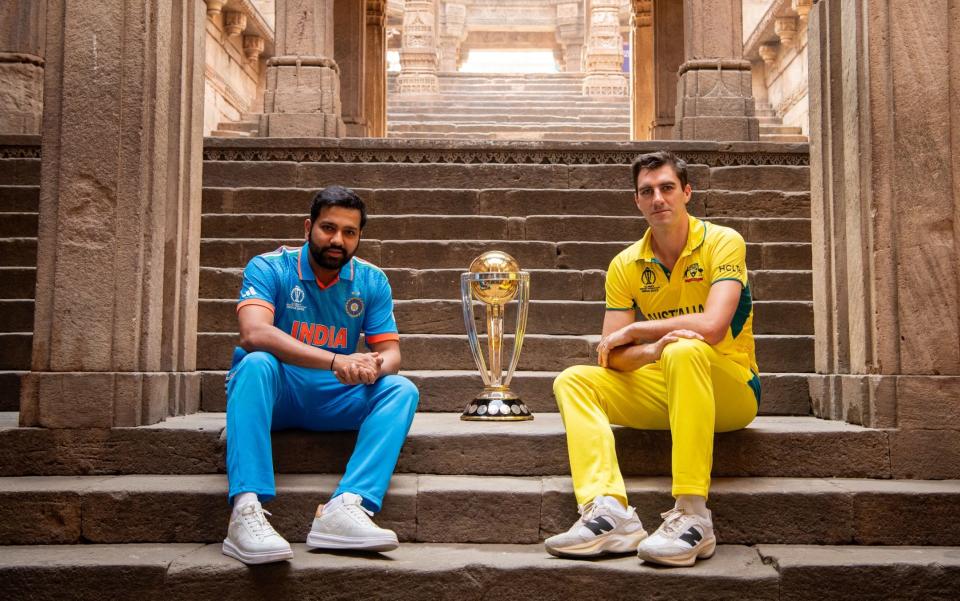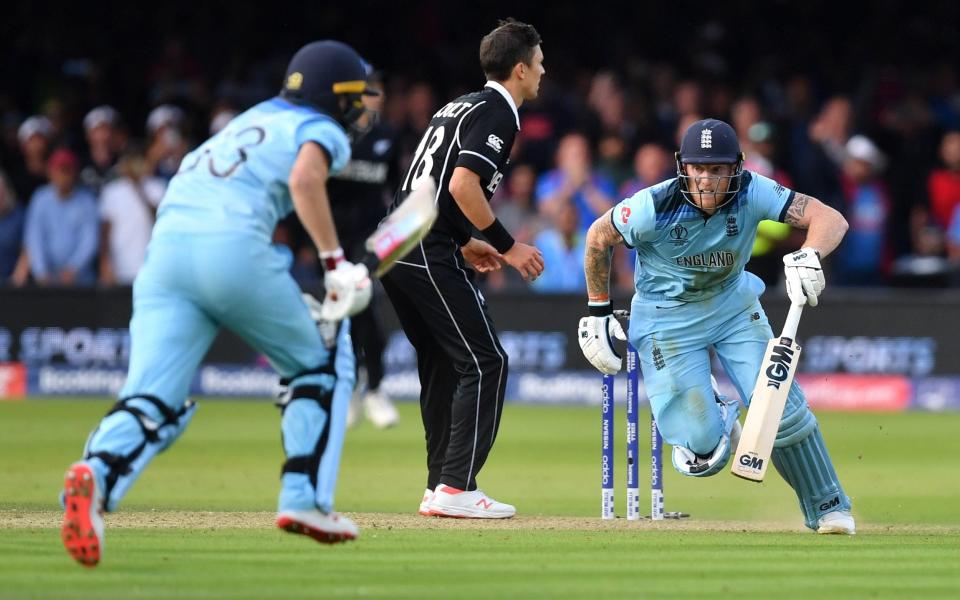Cricket World Cup 2023 final: What time is India vs Australia and how to watch in the UK

The cavernous Modi Stadium in Ahmedabad hosts the World Cup final on Sunday with hundreds of millions watching on television and close to 100,000 fans in the stadium. India are bidding for their third World Cup crown, Australia their sixth.
India completed the perfect ten, going into the final with a 100 percent record. Their batsmen are averaging almost 16 runs more per wicket than any other side. Virat Kohli is top run scorer and Mohammed Shami is the tournament’s leading wicket-taker, despite missing the first three games.
Kohli has been the World Cup king and victory would be the crowning moment of his career. Rohit Sharma has led India superbly, batting selflessly and brilliantly in the powerplay, allowing Kohli to anchor the innings.
Australia recovered from losing their first two matches to win eight on the trot and are a battle hardened team with plenty of big game experience.
The match starts at 8.30am (GMT) on Sunday.
How can I watch the World Cup on TV?
In the UK the 2023 World Cup is being broadcast live on Sky Sports Cricket, but the final will also be shown on Channel 5.
There is also a daily highlights package shown at 7pm on Channel 5, which is free to air. That same highlights programme is available to watch back on Channel 5’s on-demand platform, My5.
Full results, fixtures and schedule
This World Cup was originally slated for the spring of 2023, but the coronavirus pandemic messed up calendars, prompting the ICC to push it back by six months. England’s results are in bold.
Knockout stages
Nov 15: Semi-final 1, India beat New Zealand by 70 runs
Nov 16: Semi-final 2, Australia beat South Africa by three wickets
Nov 19: Final – Ahmedabad (8.30am, UK time)
Round-robin group stage
Oct 5: New Zealand (283-1) beat England (282-9) by nine wickets
Oct 6: Pakistan (286) beat Netherlands (205) by 81 runs
Oct 7: Bangladesh (158-4) beat Afghanistan (156) by six wickets
Oct 7: South Africa (428-5) beat Sri Lanka (326) by 102 runs
Oct 9: New Zealand (322-7) beat Netherlands (223) by 99 runs
Oct 10: Pakistan (345-4) beat Sri Lanka (344-9) by six wickets
Oct 11: India (273-2) beat Afghanistan (272-8) by eight wickets
Oct 12: South Africa (311-7) beat Australia (117) by 134 runs
Oct 13: New Zealand (248-2) beat Bangladesh (245-9) by eight wickets
Oct 16: Australia (215-5) beat Sri Lanka (209) by five wickets
Oct 17: Netherlands (245-8) beat South Africa (207) by 38 runs
Oct 18: New Zealand (288-6) beat Afghanistan (139) by 149 runs
Oct 19: India (261-3) beat Bangladesh (256) by seven wickets
Oct 21: Sri Lanka 263/5 beat Netherlands (262) by five wickets
Oct 22: India (274-6) beat New Zealand (273) by four wickets
Oct 23: Afghanistan (286-2) beat Pakistan (282-7) by eight wickets
Oct 24: South Africa (382-5) beat Bangladesh (233) by 149 runs
Oct 25: Australia (399-8) beat Netherlands (90) by 309 runs
Oct 26: Sri Lanka (160-2) beat England (156) by eight wickets
Oct 27: South Africa (271-9) beat Pakistan (270) by one wicket
Oct 28: Netherlands (229) beat Bangladesh (142) by 87 runs
Oct 28: Australia (388) beat New Zealand (383-9) by five runs
Oct 30: Afghanistan (242-3) beat Sri Lanka (241) by seven wickets
Oct 31: Pakistan (205-3) beat Bangladesh (204) by seven wickets
Nov 1: South Africa (357-4) beat New Zealand (167) by 190 runs
Nov 2: India (357-8) beat Sri Lanka (55) by 302 runs
Nov 3: Afghanistan (181-3) beat Netherlands (179) by seven wickets
Nov 4: Pakistan (200-1) beat New Zealand (401-6) by 21 runs (DLS method)
Nov 5: India (326-5) beat South Africa (83) by 243 runs
Nov 6: Bangladesh (282-7) beat Sri Lanka (279) by three wickets
Nov 7: Australia (293-7) beat Afghanistan (291/5) by three wickets
Nov 9: New Zealand (172-5) beat Sri Lanka (171) by five wickets
Nov 10: South Africa (257-5) beat Afghanistan (244 all out) by five wickets
Nov 11: Australia (307-2) beat Bangladesh (306-8) by eight wickets
Nov 12: India (410-4) beat Netherlands (250) by 160 runs
What is the format for the World Cup?
The 2023 edition follows the schedule used at the 2019 edition: a round-robin stage, followed by semi-finals and a final. In the round-robin, all 10 teams played each other once. A victory was worth two points and a tie or no result was worth one point. The top four teams qualified for the semi-finals, with the top-ranked team against the fourth-ranked team, and the second- and third-placed teams against each other.
The boundary countback rule (by which England won the 2019 World Cup final) has been dropped. From now on, if teams are tied in a knockout game and still tied after a super over, they will continue to play super overs until a winner is found.

Best of the latest odds
India: 4/9
Australia: 7/4
Odds correct as of November 18
Having a punt? First take a look at these Cricket World Cup free bets and betting offers.
Which teams are taking part?
Only 10 teams started the 2023 Cricket World Cup. They were India (who qualified automatically as hosts), New Zealand, England, Australia, Bangladesh, Pakistan, Afghanistan and South Africa (all of whom qualified based on their results in ODI cricket since the 2019 World Cup) and Sri Lanka and the Netherlands (who earned their place via a qualifying tournament this year).
Among the teams who failed to qualify are previous World Cup winners West Indies, plus Ireland and Zimbabwe.
Who is hosting the World Cup?
India are hosting the tournament despite a tit-for-tat dispute with Pakistan about tournament boycotts. India had threatened to boycott the Pakistan-hosted Asia Cup in September. In retaliation, Pakistan threated to boycott this India-hosted World Cup. That dispute was resolved by sharing the Asia Cup hosting rights between Pakistan and Sri Lanka. India’s games were all played in Sri Lanka.
At the World Cup, however, Pakistan did play India. The round-robin match between the two sides was on October 14. India won by seven wickets in Ahmedabad.
What are the venues?
Ahmedabad
No cricket ground has been designed as a temple like the Narendra Modi stadium, which is dedicated to none other than Narendra Modi, the controversial Indian Prime Minister who grew up in Ahmedabad. It tells us everything we need to know about its political uses that Modi entertained Donald Trump here when he was the US president. It was, in effect, a BJP rally. And nothing less than the largest cricket ground in the world – the largest sports stadium indeed – would do: its capacity is 132,000, which is one-third as much again as the Melbourne Cricket Ground or Eden Gardens in Kolkata. If India reach the final, curiously enough at Ahmedabad, we can be sure that it will be conducive to spinners: the ICC’s groundsmen are officially in charge of all grounds but even they will be subject to political realities. It has been known to turn in this stadium before, as Joe Root has taken five Test wickets for eight runs in one innings.
Dharamsala
Why one of India’s smaller towns, let alone cities, was promoted to an international venue in 2017 is a matter of Indian board politics. But, at an altitude of almost 5,000 feet, there can be no doubting the quality of Dharamsala’s setting and scenery. The Dalai Lama made it his home after exile from Tibet so he could still see the Himalayas and the clarity of its air is a contrast to all the cities of the plain.

Delhi
All roads lead to the Feroze Shah Kotla: this used to be a favourite phrase of Indian journalists back in the day when it was one of India’s five main Test grounds. From the outset, in the 1930s, Delhi was a Test centre alongside Bombay, Calcutta and Madras as they were known, but Delhi is no longer one of the finest grounds. It has added new stands but the ground is uncoordinated, even ramshackle, and mired in local politics. Delhi Capitals, the IPL franchise, play there but their record – they have never won the title – confirms the fact that the Kotla is no longer worthy of the country’s capital.
Mumbai
England’s cricketers have felt more at home here than any other venue in India, especially if they are staying at the luxurious Taj Mahal or a modern hotel along the seafront close to the Wankhede stadium. Bombay was the first place in India where Englishmen played cricket against Indians. More relevantly, here they staged their highest ever run-chase in T20 internationals, starring Root, against South Africa. As there is a pressure on space everywhere in Mumbai, the boundaries are relatively short and that will suit England’s six-hitters.
Bangalore
Short boundaries, around 65 metres in radius, have made the Chinnaswamy stadium into arguably the world capital of fast scoring. In the 2011 World Cup, Ireland’s Kevin O’Brien hit a 50-ball century to beat England in arguably the greatest of cricket’s giant-slayings. Before then, in 2008, Brendon McCullum had launched the IPL with 158 – in a 20-over innings – which set the tournament up for life. As for Royal Challengers Bangalore, Virat Kohli has the crowds swooning, even if their opponents knock them off in the run-chase and the Challengers have never won the title. An urbane and cosmopolitan city, India’s home of hi-tech, Bangalore has always attracted England followers as its climate and southerly latitude are blessed by a bit of altitude.

Lucknow
Lucknow ceased to exist as a cricket venue once the old Test ground at the university had been submerged by a river, but a new stadium has since been constructed, not out of town as in Nagpur, but on the city’s outskirts. Neighbouring Kanpur boomed as a cricket venue when Lucknow was in abeyance, now Lucknow has taken the lead as a Test venue and the base of the IPL franchise Lucknow Super Giants for which Mark Wood plays. The stadium, being new, has a cordon sanitaire around it, so crowds can be controlled. The police and army like to be as closely involved with the cricketers as possible in the hope of being captured on one of the many TV channels which cover cricket. Until now, however, the pitches have been uneven, as new pitches always are.
Pune
The old down-town Gymkhana club ground saw the fourth highest first-class innings, 443* by BB Nimbalkar, and England’s introduction in 1981-2 to a T20 opening batsman ahead of his time, Kris Srikkanth. But as a private member’s club its capacity was too small for the IPL era and a new ground was constructed on the outskirts of rapidly-expanding Pune, near the main road which dives down the Ghats to Mumbai, with a capacity of 42,000: a medium-sized stadium in Indian terms. England were the guests when the new stadium hosted its first international in 2012 and soon discovered that it was one of the best batting squares. The nearest Sam Curran has come to an international century was when he scored an unbeaten 95 off 83 balls against India at Pune in 2021.
Kolkata
Eden Gardens is one of the semi-final venues. Pitches have normally been slow and low, although they can be pacier for IPL games, but the unique feature of the ground is the noise, which is packed between stands on all sides. Before the Ahmedabad stadium, Eden Gardens probably held the record for the largest crowd at a cricket match (some tickets used to be sold on the black market so official figures are not reliable), possibly reaching 100,000. The first World Cup final outside

